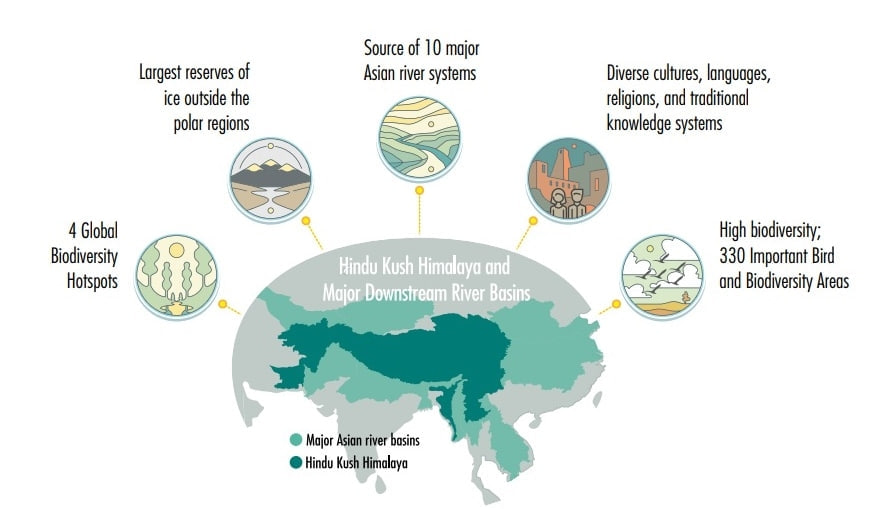
Copyright infringement not intended
Picture Courtesy: https://dialogue.earth/en/climate/11103-hindu-kush-himalayas-set-for-massive-biodiversity-loss/
Context: The Himalayas are experiencing rapid warming and biodiversity loss, prompting immediate conservation efforts to protect ecosystems and their essential functions for global and local well-being.
Biodiversity of the Himalayas
- The biodiversity of the Himalayas is extremely rich and diversified, with a vast range of species adapted to different elevations and ecological conditions.
Plant Diversity
- The Himalayas host around 10,000 vascular plant species, showing a remarkable variety of flora adapted to different elevations and climatic zones. This plant diversity includes a wide range of trees, shrubs, herbs, and other vegetation types, contributing to the unique landscapes of the region.
Bird Species
- The Himalayan region is a haven for bird diversity, with approximately 979 bird species identified. These birds inhabit diverse habitats within the Himalayas, ranging from dense forests to alpine meadows and high-altitude cliffs.
Mammalian Diversity
- The Himalayas are home to about 300 mammal species, including iconic and endangered species like the snow leopard, red panda, Himalayan tahr (a type of wild goat), and Himalayan monal (a colourful pheasant). Other notable mammals in the region include various species of deer, bears, wild cats, and small mammals adapted to mountainous terrain.
Geographic Extent and Ecological Zones
- The Himalayan mountain range spans approximately 2,400 kilometres across multiple countries, including Nepal, India, Bhutan, Pakistan, China, Myanmar, and Afghanistan. This vast region surrounds diverse ecological zones, from tropical forests in the foothills to temperate and alpine ecosystems at higher elevations.
- The ecological diversity within the Himalayas is influenced by factors such as altitude, precipitation, temperature, and geology, creating a mosaic of habitats that support a wide array of species.
Factors Supporting Biodiversity
Steep Elevation Differences
- The Himalayas show steep elevation slopes, with substantial differences in altitude over relatively short horizontal distances. These elevation differences contribute to diverse temperature bands and varied environmental conditions across the region, creating a multitude of habitats that can support a wide range of species.
Temperature Variation
- The steep elevation slopes in the Himalayas result in significant temperature variations over short vertical distances. Different temperature bands at varying elevations support different types of vegetation and wildlife, from tropical forests in lower elevations to alpine meadows and tundra at higher elevations.
Environmental Heterogeneity
- The diverse topography, geology, and climatic conditions in the Himalayas lead to environmental heterogeneity. This environmental diversity supports the coexistence of numerous plant and animal species adapted to specific ecological niches, fostering high biodiversity.
Middle Elevations (1,000 to 3,000 meters):
- The middle elevations of the Himalayas, typically ranging from 1,000 to 3,000 meters above sea level, show the highest biodiversity. These elevations often experience favourable temperatures and precipitation levels, creating optimal conditions for a rich variety of plant and animal life to thrive.
Habitat Diversity
- The Himalayan landscape comprises diverse habitats such as forests, grasslands, wetlands, rivers, lakes, and alpine meadows. This habitat diversity provides niche opportunities for different species, allowing for the coexistence of numerous plants and animal species within the region.
Role of Forests in Carbon Storage
- The role of forests in carbon storage in the Himalayas is crucial for maintaining carbon balance and mitigating climate change impacts.
Carbon Sequestration by Trees
- Trees in the Himalayas play a vital role as carbon sinks, absorbing carbon dioxide (CO2) from the atmosphere during photosynthesis and storing carbon in their biomass (trunks, branches, leaves, and roots). Forests in the Himalayas store approximately 62% of the total forest carbon in the region, making them significant reservoirs of carbon.
Biomass Accumulation in Species-Rich Communities
- Species-rich forest communities in the Himalayas promote biomass accumulation, which refers to the total amount of organic matter (mainly carbon) stored in living organisms.
- In diverse ecosystems with a variety of plant species, each species occupies unique ecological niches and utilises resources (such as water, sunlight, and nutrients) differently. This efficient resource utilisation and reduced competition among species lead to higher biomass production and carbon storage.
Efficient Resource Utilisation
- Different plant species in species-rich communities have specialised adaptations that allow them to efficiently capture and utilise resources available in their environment. For example, trees with deep roots can access groundwater, while those with broad canopies maximise sunlight interception.
- This efficient resource use minimises resource competition among plants and enhances overall productivity and carbon sequestration.
Contribution to Carbon Cycle
- Forests in the Himalayas contribute significantly to the global carbon cycle by absorbing CO2 from the atmosphere and converting it into organic carbon through photosynthesis. This stored carbon remains locked in tree biomass, soil organic matter, and forest litter, reducing the amount of CO2 in the atmosphere and mitigating climate change impacts.
Climate Change Resilience
- Healthy forests with diverse plant communities are more resilient to climate change impacts, such as increasing temperatures and changing precipitation patterns. By maintaining diverse forests, the Himalayan region can continue to function as a robust carbon sink, helping to regulate the Earth's climate and support biodiversity.

Importance of Himalayan Biodiversity
- The importance of Himalayan biodiversity cannot be overstated, given its unique ecological significance and the vital services it provides to local communities and the broader global ecosystem.
Biodiversity Hotspot
- The Himalayas are recognized as a global biodiversity hotspot, harbouring a remarkable diversity of plant and animal species, including many endemic and sensitive varieties. The region's diverse ecosystems, ranging from tropical forests to alpine meadows, support a wealth of biodiversity adapted to varying elevations and climatic conditions.
Ecosystem Services
- Himalayan ecosystems provide critical ecosystem services such as carbon sequestration, water regulation, soil conservation, and genetic diversity. The mountains act as natural water towers, supplying freshwater to millions of people in South Asia through major river systems originating from the Himalayas.
Climate Change Mitigation
- Preserving Himalayan biodiversity is crucial for mitigating climate change impacts, as forests and alpine ecosystems play a significant role in carbon storage and climate regulation. Maintaining healthy ecosystems helps buffer against the adverse effects of climate change, such as glacial melting, altered precipitation patterns, and increased frequency of extreme weather events.
Sustainable Livelihoods
- Local communities in the Himalayas depend on biodiversity for food, medicine, fuel, and other resources essential for their livelihoods and cultural practices. Conservation of biodiversity supports sustainable agriculture, eco-tourism, and traditional knowledge systems, contributing to poverty alleviation and community resilience.
Global Significance
- The Himalayan region's ecological health has global significance, influencing weather patterns, biodiversity conservation, and freshwater availability across vast regions of Asia. Protecting Himalayan biodiversity contributes to global efforts to preserve biodiversity, achieve sustainable development goals, and address climate change challenges.
Collaborative Conservation
- Collaborative efforts involving international organisations, governments, NGOs, researchers, local communities, and indigenous groups are essential for the effective conservation of Himalayan biodiversity. Integrated conservation strategies that consider socio-economic factors, traditional knowledge, and ecological resilience are key to ensuring the long-term sustainability of Himalayan ecosystems.
Challenges Faced by Himalayan Ecosystems
- The Himalayan ecosystems face several significant challenges that threaten their biodiversity and ecological stability.
Accelerated Warming and Climate Change
- The warming rate in the Himalayas is reported to be three times higher than the global average, leading to rapid changes in temperature and precipitation patterns. This accelerated warming forces many plant and animal species to migrate to higher elevations where temperatures are cooler and more suitable for survival.
- Climate change impacts, such as glacial retreat, altered monsoon patterns, and increased frequency of extreme weather events, further exacerbate environmental stresses in the Himalayan region.
Species Displacement and Habitat Loss
- As temperatures rise, species native to the Himalayas are pushed to higher elevations in search of suitable habitats, disrupting ecological balances and potentially leading to range contractions and local extinctions.
- Habitat loss and fragmentation due to human activities, including deforestation, infrastructure development, and agricultural expansion, restrict the available habitat for wildlife and exacerbate the impacts of climate change.
Invasion of Non-Native Species
- Human-induced activities such as deforestation and global trade contribute to the introduction and spread of non-native or invasive species in the Himalayan ecosystems. Invasive species can outcompete native species for resources, alter ecosystem dynamics, and disrupt local biodiversity, leading to negative ecological consequences and reduced ecosystem resilience.
Loss of Biodiversity and Ecosystem Services
- The combined effects of climate change and human activities pose significant risks to the rich biodiversity of the Himalayan region. Loss of biodiversity can impact ecosystem functions and services, including carbon sequestration, water regulation, soil fertility, and provision of food and resources to local communities.
Socio-Economic Impacts
- Local communities in the Himalayas depend on natural resources and ecosystem services for their livelihoods, including agriculture, forestry, and tourism. Environmental changes and biodiversity loss can undermine the socio-economic well-being of communities, increasing vulnerability to food insecurity, water scarcity, and natural disasters.
Conservation and Sustainable Development
- Conservation efforts in the Himalayas must strike a careful balance between ecological preservation and local socio-economic interests.
Integrated Conservation Planning
- Adopt holistic conservation approaches that consider ecological needs, biodiversity conservation, and socio-economic factors. Develop conservation plans in collaboration with local communities, scientists, policymakers, and conservation organisations to ensure comprehensive and inclusive strategies.
Community Engagement and Empowerment
- Involve local communities in conservation initiatives by promoting awareness, education, and capacity-building programs. Empower communities to participate in sustainable resource management, ecotourism, and alternative livelihood activities that reduce dependence on natural resources.
Ecosystem-Based Adaptation
- Implement ecosystem-based adaptation strategies to enhance ecosystem resilience and support species adaptation to changing climatic conditions. Restore degraded habitats, promote natural regeneration, and establish protected areas to safeguard critical ecosystems and biodiversity hotspots.
Sustainable Land Use Practices
- Encourage sustainable land use practices such as agroforestry, organic farming, and integrated watershed management to promote biodiversity conservation while enhancing agricultural productivity.
- Implement zoning and land-use planning regulations that balance conservation priorities with the needs of local agriculture, infrastructure development, and human settlements.
Promotion of Green Infrastructure
- Invest in green infrastructure projects that mitigate climate change impacts, such as afforestation, reforestation, and watershed management.
- Enhance natural carbon sequestration and water regulation functions of forests, wetlands, and other ecosystems to support climate resilience and sustainable development.
Policy and Governance
- Strengthen policy frameworks and governance mechanisms to enforce environmental laws, regulate land use, and promote sustainable development practices.
- Foster collaboration between governments, civil society organisations, and international partners to implement effective conservation policies and initiatives.
Research and Monitoring
- Conduct scientific research, monitoring, and biodiversity assessments to understand ecological changes and inform evidence-based conservation decision-making.
- Develop climate-resilient conservation strategies based on scientific data and local ecological knowledge to address emerging threats and challenges.

Conclusion
- Preserving the biodiversity of the Himalayas is not only essential for the well-being of local communities but also holds immense global significance. Conservation initiatives must prioritise the protection of these fragile mountain ecosystems to safeguard biodiversity, ecosystem services, and the resilience of our planet in the face of environmental challenges.
Must Read Articles:
FOREST FIRES IN HIMALAYAS
Source:
Down To Earth
|
PRACTICE QUESTION
Q. The Himalayas are known as the "Third Pole" for their vast freshwater reserves stored in glaciers. How will the accelerating retreat of these glaciers due to climate change impact the future monsoonal patterns in South Asia?
|




